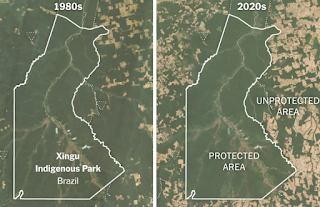Harnessing Nature's Power in the Climate Battle: COP28's Environmental Victory
Amid the headlines surrounding COP28's declaration on fossil fuels, an often-overlooked triumph emerged for nature. The agreement acknowledged the threat climate change poses to ecosystems and committed to halting deforestation, forest degradation, and the destruction of land and marine ecosystems by 2030. This alignment with a biodiversity protection agreement, aiming to safeguard 30 percent of the world's land and seas, marks a breakthrough in recognizing nature as a vital component of climate responses.
Breaking Traditional Silos: Putting Nature at the Center
The final agreement reflects a departure from traditional silos, with negotiators opting for strategies that prioritize nature in addressing climate change. Joe Walston, the executive vice president of the Wildlife Conservation Society, emphasized this shift, stating that ministers chose to integrate nature into climate change responses.
Space-Based Laser Technology: Unveiling Carbon Storage in Forests
Cutting-edge technology, such as NASA's Global Ecosystem Dynamics Investigation (GEDI) using space-based lasers, is helping scientists measure the biomass of forests worldwide. The data reveals a surprising finding: forests store approximately 30 percent more carbon than previously reported by countries. The health of these forests becomes even more critical as they play a key role in preventing the release of massive carbon stores into the atmosphere.
Protected Areas as Carbon Reserves: A Pleasant Surprise
Protected areas designated to prevent deforestation have proven to be effective in preventing the release of significant carbon stores. Using GEDI data, a study found that, in the last two decades, protected areas have averted emissions equivalent to a year's worth of fossil fuel emissions. This unexpected benefit underscores the importance of global forest conservation.
Challenges to Protected Areas: Rising Political and Economic Pressures
Despite their success, protected areas face growing political and economic pressures, challenging their continued effectiveness. With increased threats to reserves and the need to focus on conserving critical ecosystems, the article emphasizes the irreplaceable nature of certain carbon stocks.
COP28 Declaration: A Global Commitment to Protecting Nature
With nearly 200 countries committed to ending deforestation and forest degradation by 2030, the COP28 declaration signals global recognition of nature's role in combating climate change. While acknowledging the progress, advocates stress the need for more specific agreements with targets, action plans, and crucially, funding streams.
Nature's Link to Climate: An Interconnected Challenge
The recognition of fossil fuels as a problem and nature as a solution represents a victory, but the effectiveness of nature's contribution depends on the extent to which it is protected. As climate change erodes ecosystems, the ability of nature to fulfill its role becomes increasingly challenging.
Frequently Asked Questions (FAQ)
Q1: What was the significant environmental victory at COP28 mentioned in the article? A1: COP28 recognized the threat of climate change to ecosystems and committed to halting deforestation, forest degradation, and destruction of land and marine ecosystems by 2030, aligning with a biodiversity protection agreement.
Q2: How is space-based laser technology being used to benefit climate science? A2: NASA's GEDI project, using space-based lasers, helps scientists measure the biomass of forests globally, revealing that forests store approximately 30 percent more carbon than previously reported.
Q3: What unexpected benefit of protected areas does the article highlight? A3: Using GEDI data, a study found that protected areas have prevented the release of significant carbon stores, equivalent to a year's worth of fossil fuel emissions, over the last two decades.
Q4: What challenges do protected areas face, according to the article? A4: Protected areas are facing rising political and economic pressures, challenging their effectiveness. The need to focus on conserving critical ecosystems with irreplaceable carbon stocks is emphasized.
Q5: Why is the effectiveness of nature's contribution to combating climate change dependent on protection? A5: As climate change erodes ecosystems, the ability of nature to fulfill its role in combating climate change becomes more challenging. Protecting nature is crucial for it to effectively contribute to climate solutions.
#COP28, #ClimateAction, #NatureConservation, #BiodiversityProtection, #ClimateScience

